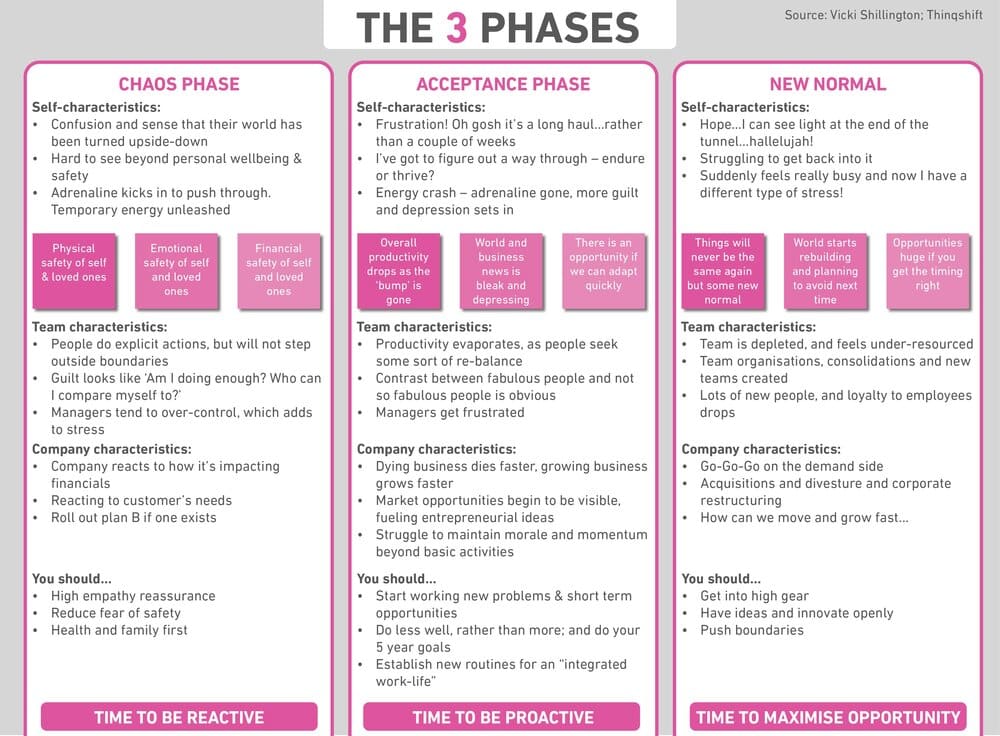Are you struggling to manage and lead your team? Do you want to know how to unleash your inner Yoda? Here’s an 8-Step plan to manage and lead your team through uncertainty.
As rewarding as leadership is, it is equally frustrating. I know this because my coaching clients have echoed the same sentiment for a year now.
Comments like “surely my team should know what to do by now, I shouldn’t have to keep reminding them,” has become a manager theme song.
Although not very PC to admit, you are not alone in feeling like this.
The reality is people are in a sort of PTSD (post-traumatic stress syndrome) from the stress of 2020. People feel despondent that the situation hasn’t shifted as expected, resulting in low intrinsic motivation levels.
As a leader, your role is to find the delicate balance between making up for lost time and being sensitive to your team’s needs. The way forward is to consider reframing your role of manager to a guide so that you can lead your team through uncertainty.
Think about the characters like Yoda and Luke Skywalker, Mr Miyagi & The Karate Kid, Professor Dumbledore and Harry Potter, Haymitch Abernathy and Katniss Everdeen in The Hunger Games.
Through these stories, the common thread is how vital a mentor’s role is to an individual’s journey.
Here are eight ways you can guide and lead your team through uncertainty:
1. DEDICATE TIME IN YOUR MEETINGS TO CONNECT ON A HUMAN LEVEL FIRST.
The only way you can effectively guide and lead your team is by first getting a realistic picture of their headspace.
Begin the meeting by checking in with them on a personal level. It can be as simple as kicking off with a one-word check-in — either a colour or a word to gauge their headspace.
Have a catch up of the weekend and ask if they have anything to share — this can be positive or negative. Perhaps they had some tough news about someone close to them.
This will also give you a greater insight into why their performance has not been consistent or perhaps you have noticed increased levels of interpersonal conflict which is out of character.

Perhaps this isn’t possible for every meeting, but indeed your Monday and Friday team meetings.
The team check-in doesn’t need to take up the entire agenda, but it will set the tone for a more engaging meeting.
Once you have connected on a human level, then begin with the work agenda.
Read 6 Tips For Managing Egos Within A Team
2. OVERWHELM IS OFTEN ABOUT NOW KNOWING WHERE TO START.
Despite feeling like it shouldn’t be your job to help people figure out their priorities, this is where your team is at now. Guide them in navigating the blur between the seemingly urgent and important tasks.
Begin by sharing your most important priorities for the week and then ask them what their focus is.
As a leader, you can now guide their thinking about why they have chosen that specific priority and redirect if necessary.
Once you have outlined each member’s top priorities, get them to define the next step. You may know you have to contact a client about a meeting but perhaps not knowing who the correct contact person is will become a barrier to action. Knowing where to start will help you better lead your team through uncertainty.
Read What Women (And Men) Really Want at Work
3. LEAD YOUR TEAM FROM WHERE THEY ARE AT NOT FROM WHERE YOU ARE.
Founder and CEO, Vips Kapadia, developed The 3 Phases diagram to explain people’s various emotions and mindsets during uncertain times and when norms suddenly change.

This explains why, although we are in year two of the pandemic, people are still experiencing it at different levels of intensity from overwhelm to acceptance.
The way to best apply this model is to map your team accordingly and then with empathy, lead your team from where they are at; not where you are.
Share this model and invite people to share their own unique experiences. It will equally help them to understand their headspace and ask for the necessary guidance.
What do they need from you to effectively navigate this time, and how can you lead them to acceptance?
4. MICROMANAGING IS NOT A STRATEGY.
Personal development expert, Tony Robbins, outlines six human needs that fundamentally affect how we make choices. Each of us prioritizes our needs differently, and we base our decisions on which needs we put first.
One of these needs is certainty. Robbins defines it as the assurance you can avoid pain and gain pleasure.
Micromanaging is an attempt to gain a false sense of control and certainty. It is not scalable and results in employees burning out, having increased stress levels and decreased productivity.
How do you strike the subtle balance between ensuring deliverables are met while giving people autonomy, the ability to be creative in problem-solving and excel in their role?
You can focus on the what and the why; let them figure out how.
Ask questions to enable your team to develop the solutions on their own and then steer them accordingly if you can see they are off course.
Daniel Pink, the author of Drive, says the way to provide autonomy support is through helping employees make progress by giving meaningful feedback, a choice over how to do things, and encouragement.
He cites a study done on a group of investment bankers that autonomy support resulted in higher job satisfaction and better job performance.
In times of uncertainty, people value having proper control over various aspects of their work — whether it’s deciding what to work on or when to do it.
Be aware of securing your need for certainty through micromanaging. Yes, things will be done your way, but the result is an unmotivated, anxious and depleted employee.
Read 10 Tips For Dealing With Negative Energies At Work
5. FOCUS ON THE SYSTEM.
Go back to basics.
How does your team structure their days?
Are they using their Outlook calendar to proactively and deliberately schedule tasks, or are they randomly responding to emails and letting other people’s urgencies dictate their day?
Ask them if you looked at their calendar for the upcoming week, would you be able to get a sense of what projects they will tackle?
Or is their calendar a sea of white space that gets filled reactively depending on the most significant fire to fight?
The results you have now are a result of your current process. You are entirely on track based on the system you use.
If you have no defined system to manage your time, then procrastination and multitasking is spot on.
If you don’t control your environment like turning off notifications on messages and the socials, then distraction will be your reality.
If you’re committed to taking ownership of your schedule, your result will be progress and efficiency.
Read Top 10 Bad Leadership Behaviors That Destroy Organisations
6. SHARE YOUR VISION.
According to Forbes.com, loneliness and isolation are the largest reported concerns amongst remote workers, leading to increased stress levels and poor decision making.
Therefore, your role as a guide and mentor is more crucial than ever.
Isolation can lead to a sense of disconnection, apathy and feelings of “what difference does it make if I send this mail now or in 3 hours”?
You can combat this by sharing the bigger picture and how they are part of it.
What is the vision of the company, and how can you incorporate that into your meetings?
In a brand-building session, I facilitated, a team identifying that their actions would enable their customers to become heroes in their communities.
This vision was the driving force behind everything they did going forwards, and productivity improved.
Having a purpose bigger than yourself reframes the mindset that it isn’t just another email or presentation.
When I’m training teams, I always show this picture of a Rube Goldberg machine to remind them that even if one tiny bolt doesn’t do its part, the entire system comes to a halt.
Make your team understand they matter, and their contribution or lack of contribution will affect the greater whole.
7. KEEP THE LESSONS, DITCH THE BAGGAGE.
Instead of trying to sweep 2020 under the rug and charge ahead, take time to do an audit of the lessons gained.
Enrol your team by asking them for their feedback and together, define the non-negotiables for 2021. You can then collectively commit to a new agreement to ensure a better way of working.
Some suggested questions are:
- What went well last year?
- What changes do you suggest we make?
- What suggestions do you have to make meetings and our processes more effective?
- Any other feedback or concerns?
- How can I best support you?
Read Top 10 Bad Leadership Behaviors That Destroy Organisations
8. PRAISE WILL GO FURTHER THAN YOU THINK.
Reach out to each individual and acknowledge their efforts. Praise is often more highly regarded in motivation. Especially now with the usual perks like increases being effected.
Remember to include your top performers in this as well; they equally need recognition for their hard work.
You can do this individually or on your team WhatsApp group. Encourage your team to do this; it doesn’t only have to come from you.
One client has created virtual icons of their team values. Every time someone lives the values such as client-centricity or curiosity, they receive a salute from the rest of the team with the corresponding badge.
FINAL THOUGHTS
When you reframe your role as a guide and mentor, you can let go of the narrative about what you “should be” doing. Resistance to the situation will only frustrate you. Instead, view this as an excellent opportunity for your growth and to practice the skills of empathy and compassion.
Every guide provides a unique set of tools. Yoda shows how to give support, offer challenges that enable one to learn and grow, and provide vision so that the mentee gains self-assurance and independence.
Professor Dumbledore provides Harry with insight and the importance of love and friendship. He gives him the tools to face his challenges rather than deprive him of the opportunity to try.
Haymitch mentors Katniss in strategy to navigate the game. He teaches Katniss to think on her feet, and above all to think for herself.
Are you ready to unleash your inner Yoda? Lead your team through uncertainty?
What are the tools and lessons you are going to impart to your team?
How will their journey be better because of your leadership?
Warm wishes
Lori
Written by: Lori Milner Get Lori’s Personal Newsletter Every Week. It’s just the boost of inspiration you need! Stay connected at https://beyondthedress.co.za/newsletter-sign-up Originally appeared on: Beyond The Dress Republished with permission










Leave a Reply